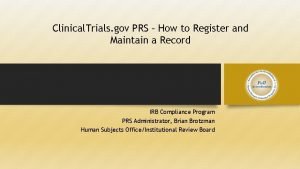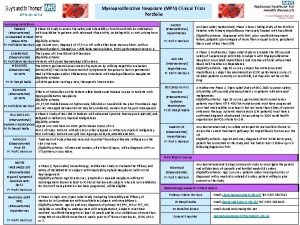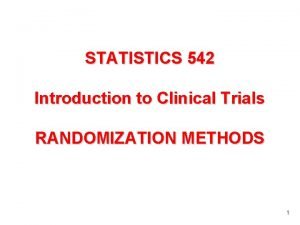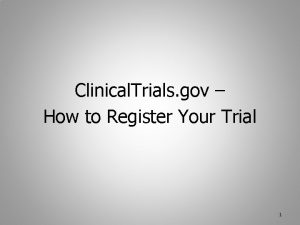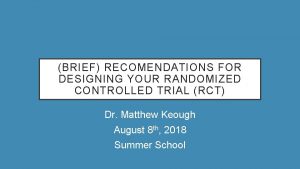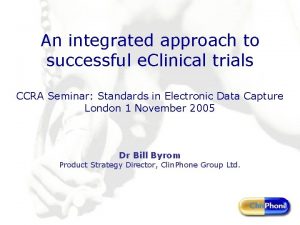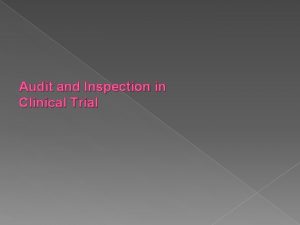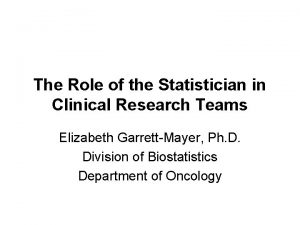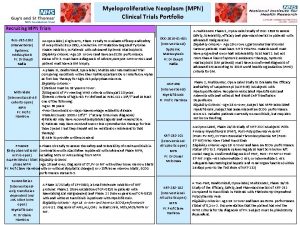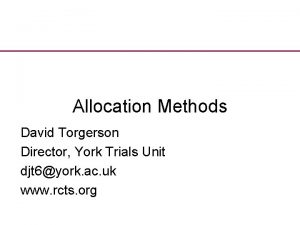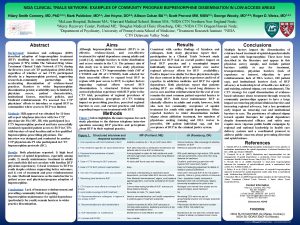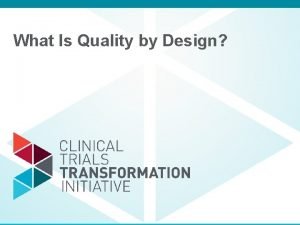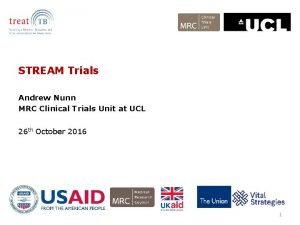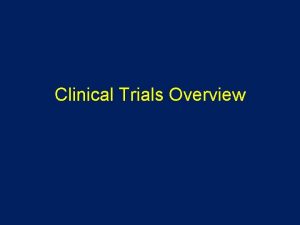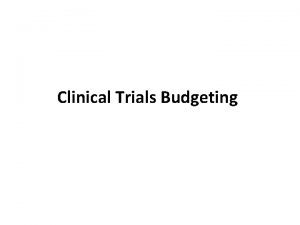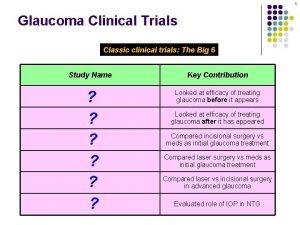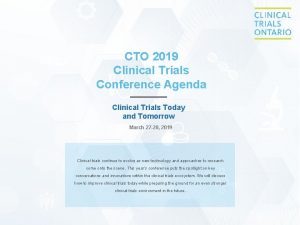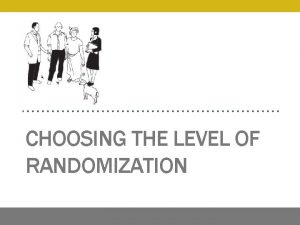Clinical Trials Common Terminology Randomization Chance allocation to


















- Slides: 18

Clinical Trials


Common Terminology • Randomization – Chance allocation to one of two or more treatments – To insure comparability of groups on factors (known and unknown)other than the treatment – To control bias – To allow valid application of statistical methods

• Placebo- an inactive substance given to randomly selected patients in a clinical trial so that all patients and investigators believe that they are receiving treatment. • Bias-systematic error introduced into sampling or testing by selecting or encouraging one outcome or answer over others

Blinded Trials • Single Blind- The subject is not told which group he/she is in. • Double Blind- Neither the subject nor the investigator knows which treatment the patient is receiving. • Triple Blind- Neither the patient nor the investigator nor the clinical personnel (monitors, statisticians, etc. ) knows which treatment the patient is getting.


Phase 1 Studies • Exploratory • Primarily concerning safety • Dose-ranging or dose-seeking (route and schedule too) • Define maximum tolerated dose • Define toxicities • Usually small number of people-approximately 5 -15

• Usually performed on healthy individuals • Usually one institution involved

Phase 2 Studies • Confirmatory • Demonstrates safety • Should already have dose, route, schedule from phase 1 trial • Obtain preliminary evidence of efficacy to support phase 3 trial • Performed in sick people • Usually one institution

Phase 2 • Usually more patients than in phase 1 studies. . usually 10 -100 • Meet with FDA at this point to present safety and efficacy data and to present plans for the future definitive Phase 3 trials; FDA gives input. .

Common Problems • Lack of good controls—can weaken study • Poorly defines hypotheses and outcomes • Inadequate sample size which can translate into inadequate statistical “power” and/or precision; more common in Phase 2 trials than in Phase 3 trials • Noncompliance • Results published too early or not published at all (usually negative results)

Phase 3 Studies • Exploratory • Comparative • Required by FDA to demonstrate efficacy-the definitive study or studies upon which the potential approval is based • Almost always randomized • Ideally a double-blind randomized, placebocontrolled trial (some exceptions apply for ethical reasons)

• In almost all cases, larger than phase 1 or phase 2 studies—approximately 50 -2000 subjects • Often conducted at multiple centers • In cases of severe illness, new routes to FDA approval may be instigated (i. e. combinations of phases 2 and 3 trials)

Phase 4 Studies • Post-marketing surveillance • Larger scale-longer term • May pick up ADRs (adverse reactions) not previously seen • Long-term safety. . broader experience Example of drugs taken off the market after in clinical use: DES, Thalidomide, Copper IUD

Choice of Control Groups • Historical Controls- A group “comparable” to current study patients treated or observed in a previous time period (must have very good justification) • No treatment current controls- a group randomized to receive no treatment but are “comparable” to study patients (difficult to justify unless observation only is a standard)

Control Groups • Placebo concurrent control- a group randomized to receive placebo for comparison with study treatment group; in some situations, ethical problems arise • Active-treatment control- a group randomized to receive an active treatment (best current treatment) for comparison with study treatment group

Control Groups – Crossover design- patient acts as his or her own control- patients are randomized to a specific sequence of treatments eliminates many sources of bias, but some difficulties may arise in carryover effects

 Clinicaltrials gov prs
Clinicaltrials gov prs Site initiation visit ppt
Site initiation visit ppt Professor claire harrison
Professor claire harrison Randomization in statistics
Randomization in statistics Clinical trials.gov login
Clinical trials.gov login Clinical trials
Clinical trials Clinical trial api
Clinical trial api Dhl clinical trials
Dhl clinical trials Phs human subjects and clinical trials information
Phs human subjects and clinical trials information Iwr clinical study
Iwr clinical study Difference between inspection and audit
Difference between inspection and audit Role of statistician in clinical trials
Role of statistician in clinical trials Readyset ohsu
Readyset ohsu Clinical hysteria salem witch trials
Clinical hysteria salem witch trials Mpn clinical trials
Mpn clinical trials York trials unit
York trials unit Nida clinical trial network
Nida clinical trial network Clinical trials quality by design
Clinical trials quality by design Andrew nunn
Andrew nunn
